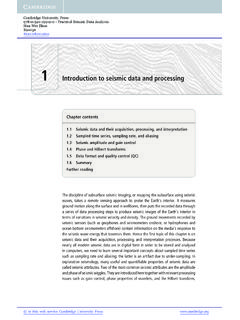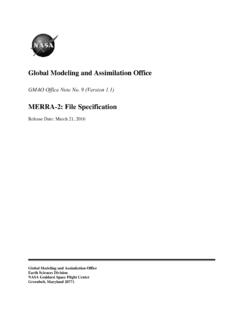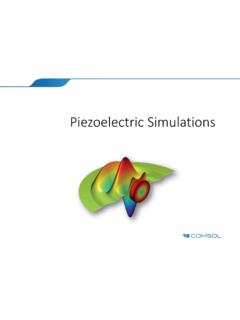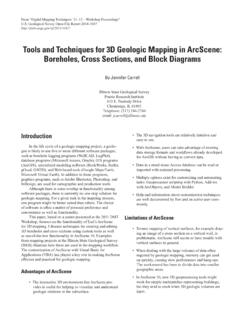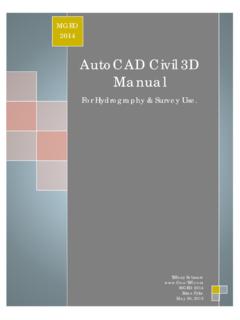Transcription of Bezier Curves and Splines - MIT OpenCourseWare
1 Matusik Computer Graphics B zier Curves and Splines Wojciech Matusik MIT CSAIL Anything on your mind concerning Assignment 0? Any questions about the course? Assignment 1 ( Curves & Surfaces) Linear algebra review session 2 Before We Begin Smooth Curves in 2D Useful in their own right Provides basis for surface editing 3 Today This image is in the public domainSource:Wikimedia Commons Polylines Sequence of vertices connected by straight line segments Useful, but not for smooth Curves This is the representation that usually gets drawn in the end (a curve is converted into a polyline) Smooth Curves How do we specify them? A little harder (but not too much) 4 modeling 1D Curves in 2D A type of smooth curve in 2D/3D Many different uses 2D illustration ( , Adobe Illustrator) Fonts ( , PostScript, TrueType) 3d modeling Animation: trajectories In general: interpolation and approximation 5 Splines ACM 1987 Principles of traditional animation applied to 3D computer animation ACM.
2 All rights reserved. This content is excluded from ourCreative Commons license. For more information, Demo 7 How Many Dimensions? 8 How Many Dimensions? This curve lies on the 2D plane, but is itself 1D. 9 How Many Dimensions? This curve lies on the 2D plane, but is itself 1D. You can just as well define 1D Curves in 3D space. 10 Two Definitions of a Curve A continuous 1D set of points in 2D (or 3D) A mapping from an interval S onto the plane That is, P(t) is the point of the curve at parameter t Big differences It is easy to generate points on the curve from the 2nd The second definition can describe trajectories, the speed at which we move on the curve User specifies control points We will interpolate the control points by a smooth curve The curve is completely determined by the control points.
3 11 General Principle of Splines 12 Physical Splines See Courtesy of The Antique Boat Two Application Scenarios Approximation/interpolation We have data points , how can we interpolate? Important in many applications User interface/ modeling What is an easy way to specify a smooth curve? Our main perspective today. Image courtesy of SaphireS on Wikimedia Commons. License: CC-BY-SA. This content is excluded from our Creative Commons license. Formore information, see Questions? Specified by a few control points Good for UI Good for storage Results in a smooth parametric curve P(t) Just means that we specify x(t) and y(t) In practice: low-order polynomials, chained together Convenient for animation, where t is time Convenient for tessellation because we can discretize t and approximate the curve with a polyline 15 Splines 16 Durand Tessellation It is easy to rasterize mathematical line segments into pixels OpenGL and the graphics hardware can do it for you But polynomials and other parametric functions are harder Image courtesy of Phrood on Wikimedia Commons.
4 License: content is excluded from ourCreative Commons license. For moreinformation, see Tessellation t0 t1 t2 tn To display P(t), discretize it at discrete ts 18 Tessellation t0 t1 t2 tn It s clear that adding more points will get us closer to the curve. 19 Tessellation t0 t1 t2 tn It s clear that adding more points will get us closer to the curve. Interpolation Goes through all specified points Sounds more logical Approximation Does not go through all points 20 Interpolation vs. Approximation Interpolation Approximation Interpolation Goes through all specified points Sounds more logical But can be more unstable Approximation Does not go through all points Turns out to be convenient We will do something in between.
5 21 Interpolation vs. Approximation Interpolation Approximation 22 Questions? User specifies 4 control points P1 .. P4 Curve goes through (interpolates) the ends P1, P4 Approximates the two other ones Cubic polynomial 23 Cubic B zier Curve 24 Cubic B zier Curve That is, P(t) = (1-t) P1 + 3t(1-t) P2 + 3t (1-t) P3 + t P4 25 Cubic B zier Curve Verify what happens for t=0 and t=1 P(t) = (1-t) P1 + 3t(1-t) P2 + 3t (1-t) P3 + t P4 4 control points Curve passes through first & last control point 26 Cubic B zier Curve Courtesy of Seth Teller. Used with permission. 4 control points Curve passes through first & last control point Curve is tangent at P1 to (P1-P2) and at P4 to (P4-P3) 27 Cubic B zier Curve A B zier curve is bounded by the convex hull of its control points.
6 28 Questions? Explanation 1: Magic! Explanation 2: These are smart weights that describe the influence of each control point Explanation 3: It is a linear combination of basis polynomials. 29 Why Does the Formula Work? P(t) is a weighted combination of the 4 control points with weights: B1(t)=(1-t) B2(t)=3t(1-t) B3(t)=3t (1-t) B4(t)=t First, P1 is the most influential point, then P2, P3, and P4 30 Weights P(t) = (1-t) P1 + 3t(1-t) P2 + 3t (1-t) P3 + t P4 P2 and P3 never have full influence Not interpolated! 31 Weights P(t) = (1-t) P1 + 3t(1-t) P2 + 3t (1-t) P3 + t P4 32 Questions? Explanation 1: Magic! Explanation 2: These are smart weights that describe the influence of each control point Explanation 3: It is a linear combination of basis polynomials.
7 The opposite perspective: control points are the weights of polynomials!!! 33 Why Does the Formula Work? Understand relationships between types of Splines Conversion Express what happens when a spline curve is transformed by an affine transform (rotation, translation, etc.) Cool simple example of non-trivial vector space Important to understand for advanced methods such as finite elements 34 Why Study Splines as Vector Space? In 3D, each vector has three components x, y, z But geometrically, each vector is actually the sum i, j, k are basis vectors Vector addition: just add components Scalar multiplication: just multiply components 35 Usual Vector Spaces i j k Polynomials Can be added: just add the coefficients Can be multiplied by a scalar: multiply the coefficients 36 Polynomials as a Vector Space Polynomials In the polynomial vector space, {1, t.}
8 , tn} are the basis vectors, a0, a1, .., an are the components 37 Polynomials as a Vector Space 38 Questions? Closed under addition & scalar multiplication Means the result is still a cubic polynomial (verify!) Cubic polynomials also compose a vector space A 4D subspace of the full space of polynomials The x and y coordinates of cubic B zier Curves belong to this subspace as functions of t. 39 Subset of Polynomials: Cubic More precisely: What s a basis? A set of atomic vectors Called basis vectors Linear combinations of basis vectors span the space any cubic polynomial is a sum of those basis cubics Linearly independent Means that no basis vector can be obtained from the others by linear combination Example: i, j, i+j is not a basis (missing k direction!)
9 40 Basis for Cubic Polynomials i j k In 3D Any cubic polynomial is a linear combination of these: a0+a1t+a2t2+a3t3 = a0*1+a1*t+a2*t2+a3*t3 They are linearly independent Means you cannot write any of the four monomials as a linear combination of the others. (You can try.) 41 Canonical Basis for Cubics 1 t t2 t3 For example: {1, 1+t, 1+t+t2, 1+t-t2+t3} {t3, t3+t2, t3+t, t3+1} These can all be obtained from by linear combination Infinite number of possibilities, just like you have an infinite number of bases to span R2 42 Different Basis 2D examples For example: 1, 1+t, 1+t+t , 1+t-t +t t , t +t , t +t, t +1 43 Matrix-Vector Notation Change-of-basis matrix Canonical monomial basis These relationships hold for each value of t For example: 1, 1+t, 1+t+t2, 1+t-t2+t3 t3, t3+t2, t3+t, t3+1 44 Matrix-Vector Notation Change-of-basis matrix Canonical monomial basis Not any matrix will do!
10 If it s singular, the basis set will be linearly dependent, , redundant and incomplete. For B zier Curves , the basis polynomials/vectors are Bernstein polynomials For cubic Bezier curve: B1(t)=(1-t) B2(t)=3t(1-t) B3(t)=3t (1-t) B4(t)=t (careful with indices, many authors start at 0) Defined for any degree 45 Bernstein Polynomials 46 Properties of Bernstein Polynomials for all 0 t 1 Sum to 1 for every t called partition of unity These two together are the reason why B zier Curves lie within convex hull B1(0) =1 Bezier curve interpolates P1 B4(1) =1 Bezier curve interpolates P4 P(t) = P1B1(t) + P2B2(t) + P3B3(t) + P4B4(t) Pi are 2D points (xi, yi) P(t) is a linear combination of the control points with weights equal to Bernstein polynomials at t But at the same time, the control points (P1, P2, P3, P4)










